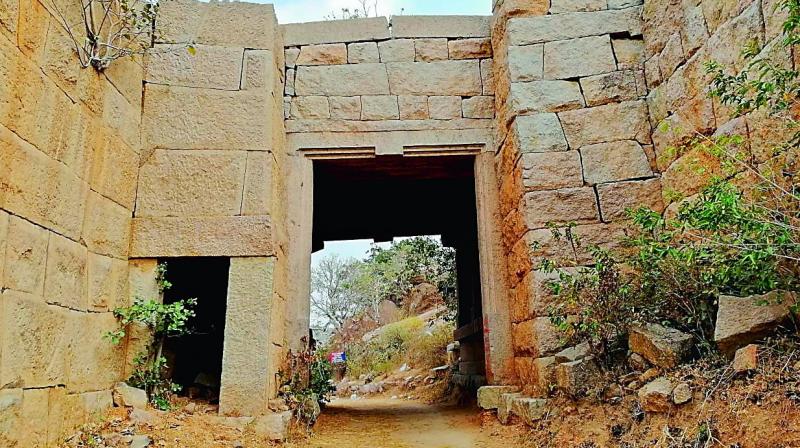The unexplored 14th century Rachakonda Fort
No signage, no facilities at fort built by Padmanayaka Velama King Anapotanayaka.

Hyderabad: If you are driving down National Highway 65 towards Vijayawada to the Rachakonda Fort, better have a map. There is no road sign to show how you should reach this 14th century fort, 80 km from Hyderabad. You have to drive under the flyover at Choutuppal and take a right to Koyalgudem.
For a healthy breakfast drive up to Village Aaharam, which serves organic food and offers clean toilets, and take a U-turn to Koyalgudem. There is another place, Bhon Chesera’ which seems crowded. At Koyalgudem, take a left turn and ask for directions. It is a small village known for its weavers, the few who still weave Ikat fabric in the state. They are on the outskirts of the village and if you are lucky you can see colourful skeins hanging outside small houses with tiled roofs.
A visit to Koyalgudem would take almost half a day and combining it with the fort climb would be tiring. You need a couple of hours at the fort.
A beautiful road, lonely and with little traffic, takes you through the rural countryside. The few people you meet on the road seem shocked that you would want to visit the fort but give you directions. There are two humongous Lord Ganeshas carved out of stone en route which have been painted over.
From Koyalgudem, it is a 28-km drive to the fort and there is still no signage. Finally at a small T-junction a board announces Rachakonda village but makes no mention of the fort. As you drive on and look to your right you see signs of the fort, starting with a small mandapam which probably was a lookout.
A board at the entrance announces that it is under the protection of the archaelogy department, and there it ends. The gate is made of stones and rocks stacked in an organised manner. That it is still standing is what surprises you. As you enter this gate you see Veerabhadraswamy etched on the wall with an inscription, which could be a prayer.
The first impression one gets is a group of tan mountains, with some of the rocks positioned on the edge. But then, they have lasted so long there is no fear of them falling off. There is no continuous building of the fort; instead, the ramparts have been built wherever the then ruler thought was a weakness or an entry point of attack. And so there are huge rocks and then suddenly some man-made structures like a mandapam or a wall and so on. You get to see the amazing landscape of the igneous rocks of the Deccan Plateau.
The Rachakonda Fort was built by the Padmanayaka Velama King Anapotanayaka in the 14th century AD. It was built when the capital shifted from Anumagallu (now Amangal) to Rachakonda. The fort is spread across several of these natural structures and seems unending.
The Recharla Padmanayaka kings were chieftains of the Kakatiya kings and became independent when the Kakatiya dynasty lost its glory in the beginning of the 14th century.
One must appreciate the great masonry work for this is not a construction with mortar and cement but an artful piling of stones. That it has lasted for so long is proof that these engineering skills worked.
Nature has been used cleverly, with gaps in between used as walkways, strategic positioning of rocks used as gateways. Cave-like structures must have been living quarters, with vantage points giving them a bird’s eye view of anyone coming or going.
Only the mandapams have been built. While the smaller ones might have been lookout points there are larger ones which might have been used for other purposes such as for dancing, music, etc. One of them at the ground level is totally overgrown with bushes.
There is an old Rama temple within the fort and a bit away. Spacious on the outside, the sanctum is practically under a root in a small cave. It now has a new doorway and a new sthamba.
There is nothing much to see in the fort except to enjoy the breeze, admire the engineering skills of the bygone era and trek along trodden paths. This might take you some time and so it is advisable to carry some water and snacks with you.
Early morning treks are advisable, because there is no shelter in terms of tree cover. But even a slow trek will take till noon and it is better to get out of the fort before 4 pm, as the road gets lonely. But if you want to visit history in the lap of nature, then this is the place.

